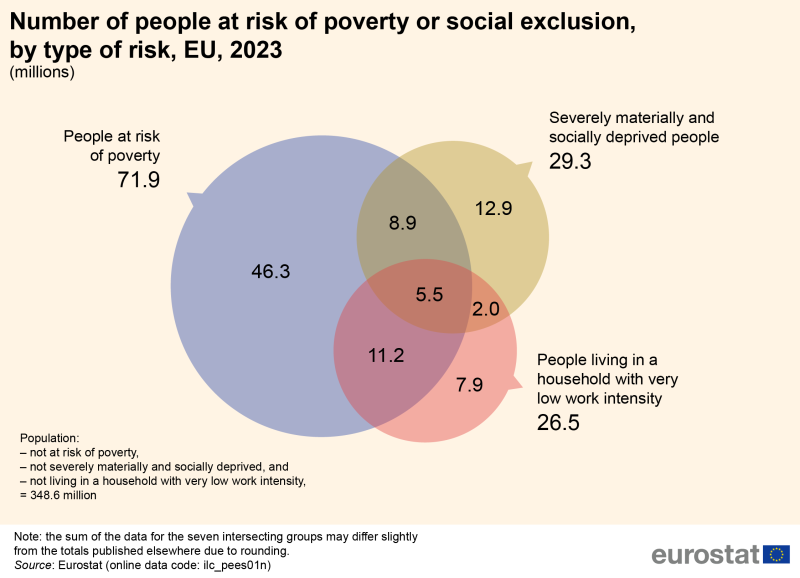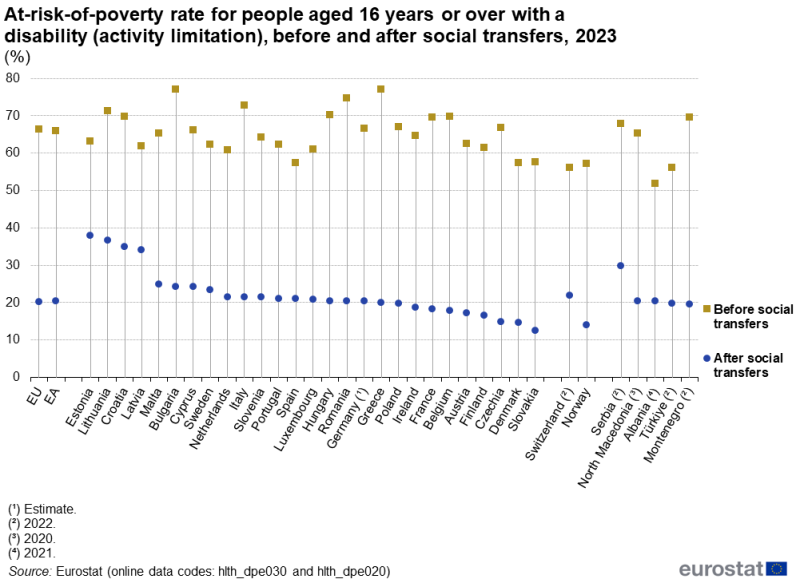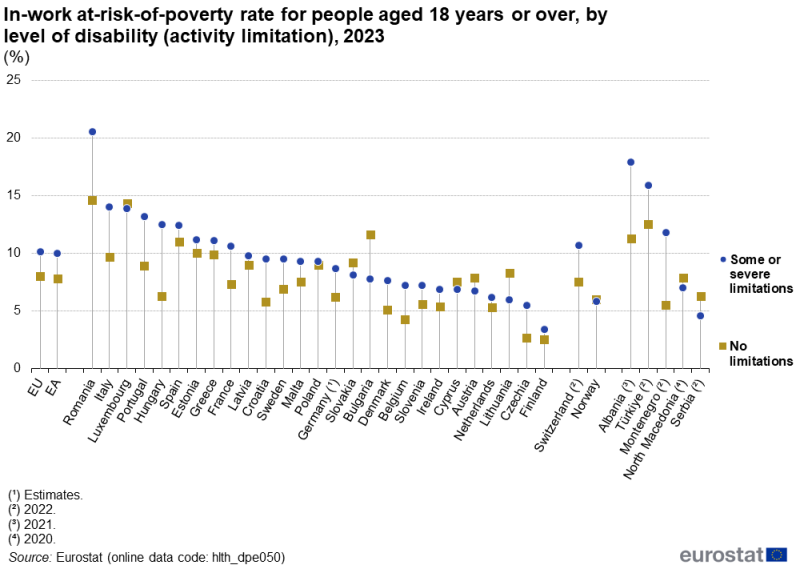Data extracted in: July 2024.
Planned article update: December 2025.
Highlights
In 2023 in the EU, 28.8% of people with a disability were at risk of poverty or social exclusion, compared with 18.0% among people with no limitations.
In 2023 in the EU, 66.4% of people with a disability would have been at risk of poverty, but after taking account of social transfers (such as benefits and allowances) the share was 20.2%.

(millions)
Source: Eurostat (ilc_pees01n)
This article is part of a set of articles on disability and presents various aspects of the income, social and employment situation of people with a disability (activity limitation). Income is a key measure of the economic well-being of individuals. The findings presented in this article are based on the European Union’s (EU’s) statistics on income and living conditions (EU-SILC). These are based on respondents’ assessments of their limitations as well as their household’s income, social and employment situation.
In EU-SILC, disability is approximated according to the concept of global activity limitation, which is defined as a limitation – because of health problems – in carrying out usual activities (for at least the previous 6 months). This is considered to be an adequate proxy for disability, both by the scientific community and organisations representing people with disabilities. This definition is also in line with the concept of disability as set out in the European disability strategy 2010–2020 and its successor, the Strategy for the rights of persons with disabilities 2021–2030.
The financial situation of households has become a key area of concern during the cost-of-living crisis. A growing share of people in the EU, and particularly those in vulnerable situations, face difficulties paying their energy bills and paying for food. The links between poverty and ill-health suggest that the cost-of-living crisis may worsen health inequalities across the EU.
At risk of poverty or social exclusion
Higher rate of being at risk of poverty or social exclusion among people with a disability
The at risk of poverty or social exclusion indicator measures the number or percentage of people who are
- at risk of poverty and/or
- severely materially and socially deprived and/or
- living in a household with a very low work intensity.
The number of people at risk of poverty or social exclusion is a headline indicator to monitor the European pillar of social rights (EU 2030 targets); it is presented in this article both in its aggregated form and for its constituent parts.

(%)
Source: Eurostat (hlth_dpe010), (hlth_dpe020), (hlth_dm010) and (hlth_dpe040)
In 2023 in the EU, 28.8% of people aged 16 years or over with a disability (activity limitation) were at risk of poverty or social exclusion, compared with 18.0% of people with no disability. Similar results were observed for the at-risk-of-poverty rate (20.2% compared with 14.1%), severe material and social deprivation rate (11.0% compared with 4.9%) and the share of individuals aged less than 65 years who lived in households with very low work intensity (16.7% compared with 5.7%). The last of these comparisons reflects, at least in part, the more difficult access to labour markets faced by people with a disability.
The share of people with a disability (activity limitation) who were at risk of poverty or social exclusion in 2023 ranged, among the EU countries, from 18.6% in Slovakia to 42.4% in Bulgaria and 42.7% in Lithuania. As such, the share was 2.3 times as high in Lithuania as in Slovakia. Among the non-EU countries shown in Table 1, higher shares were observed in Albania (54.6%; 2021 data), Serbia (45.0%; 2022 data) and Montenegro (42.7%; 2022 data).
In 2023, people with no disability were less likely to be at risk of poverty or social exclusion than those with a disability (activity limitation) in all EU countries. In absolute terms, the difference between the shares for people with and without a disability was smallest in Slovakia (3.8 percentage points (pp)). The 3 widest gaps were recorded in Lithuania (23.1 pp), Croatia (22.6 pp) and Estonia (22.1 pp). The smallest relative differences recorded in EU countries were in Italy, Slovakia and Greece, where the share of people at risk of poverty or social exclusion was 1.3 times as high for people with a disability as for people without; a slightly narrower gap was observed in Türkiye (1.2 times as high; 2022 data). By contrast, the largest relative difference was recorded in Croatia, where the share of people at risk of poverty or social exclusion was 2.5 times as high for people with a disability as for people without.
People with a disability were most likely to be at risk of poverty in the Baltic countries and Croatia
The at-risk-of-poverty rate among people aged 16 years or over with a disability (activity limitation) was highest in 2023 in the Baltic countries and Croatia: 37.9% in Estonia, 36.6% in Lithuania, 34.9% in Croatia and 34.1% in Lativa. The lowest rates among people with a disability were in Slovakia (12.4%), Denmark (14.7%) and Czechia (14.9%). As such, the rate was 3.1 times as high in Estonia as in Slovakia.
With regard to the share of people at risk of poverty, the absolute gap between people with or without a disability was also relatively wide in 2023 in the Baltic countries, as well as in Croatia, all in the range of 17.0 to 21.0 pp. By contrast, Slovakia recorded at-risk-of-poverty rates that were slightly lower for people with a disability than for those without (a gap of 0.2 pp); among non-EU countries a slightly wider gap with a higher rate for people without a disability was observed in Albania (0.3 pp; 2021 data). In relative terms, the widest gap was recorded in Croatia, where people with a disability were 2.5 times as likely to be at risk of poverty than people with no disability. As well as Slovakia, Romania and Greece also recorded small relative differences, as the share of people at risk of poverty was at most 1.1 times as high for people with a disability than for people without; among non-EU countries, similarly narrow gaps were also observed in Albania (2021 data), North Macedonia (2020 data), Montenegro and Türkiye (both 2022 data).
People with a disability were most likely to experience severe material and social deprivation in Romania and Bulgaria
Among people aged 16 years or over with a disability, severe material and social deprivation was most common in 2023 in Romania (28.4%) and Bulgaria (28.1%). These 2 shares were notably higher than in the other EU countries, as the next highest share was 17.9% in Hungary; among non-EU countries, shares above that observed in Romania were recorded for Albania (49.2%; 2021 data), Serbia (29.7%; 2022 data) and Montenegro (28.8%; 2022 data). In 15 EU countries, fewer than 10.0% of people with a disability experienced severe material and social deprivation. The lowest share was 4.3% in Czechia. As such, the share was 6.6 times as high in Romania as in Czechia.
In 2023, all EU countries recorded a higher share of people experiencing severe material or social deprivation among people with a disability than among those without. In absolute terms, the widest gap was in Romania, a difference of 13.3 pp, while double-digit differences were also recorded in Bulgaria and Hungary. Wider gaps were observed in 3 non-EU countries: 17.5 pp in Serbia (2022 data), 16.1 pp in Albania (2021 data) and 13.6 pp in Montenegro (2022 data). In relative terms, people with a disability in Estonia were 5.4 times as likely to experience severe material or social deprivation as people with no disability; among non-EU countries, this ratio was marginally higher (5.5 times as high) in Switzerland (2022 data). By contrast, in Greece people with a disability were 1.4 times as likely to experience severe material or social deprivation as people with no disability.
People with a disability were most likely to live in a household with very low work intensity in Belgium and Ireland
The final indicator in Table 1 concerns people aged less than 65 years and shows the share living in a household with very low work intensity. Among people with a disability, this share was highest in 2023 in Belgium (27.8%) and Ireland (26.5%); among non-EU countries, it was higher in North Macedonia (29.6%; 2020 data) and Montenegro (28.4%; 2022 data). At the other end of the range, Romania (7.6%) and Slovakia (7.7%) had the lowest shares among the EU countries. As such, the share was 3.7 times as high in Belgium as in Romania.
In 2023, all EU countries recorded a larger share of people aged less than 65 years living in a household with very low work intensity among people with a disability than among those without. In absolute terms, the widest gaps were in Belgium (21.9 pp) and Ireland (21.7 pp), while the narrowest gap was in Romania (3.7 pp). In relative terms, people in Estonia with a disability were 6.8 times as likely to live in a household with very low work intensity as people with no disability. By contrast, in Romania people with a disability were 1.9 times as likely to live in a household with very low work intensity as people with no disability; among non-EU countries, lower ratios were observed in Montenegro (1.6 times as high: 2022 data), Albania (1.6; 2021 data) and Türkiye (1.7; 2022 data).
Impact of social transfers on the at-risk-of-poverty rate
The at-risk-of-poverty rate among people with a disability was lowered greatly by social transfers
In 2023 in the EU, 66.4% of people aged 16 years or over with a disability would have been at risk of poverty if social transfers (social benefits and allowances) hadn’t taken place; this is the at-risk-of-poverty rate before social transfers. By contrast, slightly more than a fifth (20.2%) of the same people were at risk of poverty after taking social transfers into account – see Figure 1.
For people with a disability, the at-risk-of-poverty rate before social transfers in 2023 ranged among the EU countries from 77.1% in Bulgaria to 57.3% in Denmark.
In all EU countries, for people with a disability, the at-risk-of-poverty rate after social transfers in 2023 was lower than the rate before transfers. The difference in these 2 rates was generally large, ranging from 57.0 pp in Greece (77.0% before social transfers compared with 20.0% after social transfers) to 25.3 pp in Estonia (63.2% compared with 37.9%).

(%)
Source: Eurostat (hlth_dpe030) and (hlth_dpe020)
In-work poverty
People with a disability were more likely to face in-work poverty than people with no disability
Regardless of whether people have a disability or not, being in employment generally reduces the risk of poverty. In 2023, 8.3% of employed people in the EU aged 18 years or over were at-risk-of-poverty, while the share was 15.5% for all people of the same age group. As such, employment reduces the risk of poverty but doesn’t make it disappear. The in-work at-risk-of-poverty rate, in other words the risk of poverty among employed people, is a key indicator of labour market integration for people having a disability.
In the EU, 10.1% of employed people with a disability were at risk of-poverty in 2023, while this rate was 8.0% among employed people with no disability – see Figure 2.
In 2023, the highest in-work at-risk-of-poverty rate among people with a disability was observed in Romania (20.5%), far above the next highest rate among the EU countries, 14.0% in Italy. The lowest rate was recorded in Finland (3.4%).
In Luxembourg, Cyprus, Slovakia and Austria, the in-work at-risk-of-poverty rate was slightly higher among people without a disability than among those with a disability (a gap of no more than 1.2 pp), while in Lithuania (2.3 pp higher for people with no disability) and Bulgaria (3.8 pp), the gap was wider. In the remaining 21 EU countries, the in-work at-risk-of-poverty rate was lower among people without a disability than among those with a disability. The widest gaps between the rates were in Hungary (6.2 pp) and Romania (5.9 pp). Among non-EU countries, a wider gap was observed in Albania (6.6 pp; 2021 data) and in Montenegro (6.3 pp; 2022 data).

(%)
Source: Eurostat (hlth_dpe050)
Source data for tables and graphs
Data sources and availability
EU-SILC is the source of comparative statistics on income distribution and social inclusion in the EU. It provides annual data for the EU countries as well as most EFTA and enlargement countries on income, poverty, social exclusion and other aspects of living conditions.
The reference population for EU-SILC is limited to private households and their current members residing in the territory of the surveying country at the time of data collection. People living in collective households and institutions are generally excluded from the reference population; this constitutes a limitation for disability statistics. All household members are surveyed, but only those aged 16 years or over are interviewed.
The source is documented in more detail in this background article, which provides information on the scope of the data, its legal basis, the methodology employed, as well as related concepts and definitions.
Context
Disability statistics are used to measure the impact and effectiveness of EU policy aimed at ensuring equal rights for people with disabilities. The EU has adopted several strategies aimed at improving the lives of people with disabilities
- by reducing discrimination and inequalities
- by providing support to enjoy fully their human rights, fundamental freedoms and EU rights on an equal basis with others.
In light of this, the 2021–2030 EU Strategy for the rights of people with disabilities sets EU objectives and priority actions in several areas, such as accessibility, citizens’ rights, the quality of life, equal access and non-discrimination, and the promotion of the rights of people with disabilities. To find out more, please visit the webpage on the monitoring framework for the objectives and actions of this strategy.
To ensure sound monitoring and reporting of this topic, the European Commission is reinforcing the collection of data on the situation of people with disabilities in areas where knowledge gaps have been identified, for example in relation to access to the labour market.
The EU is also a signatory of the United Nations (UN) Convention on the Rights of Persons with Disabilities (CRPD).
Explore further
Other articles
Database
- Disability (dsb), see
- Income and living conditions (dsb_ilc)
- Income distribution and poverty (dsb_ilcip)
- Material and social deprivation (dsb_ilcms)
Thematic section
Publications
Methodology
External links
Health
- European Commission – Directorate-General for Health and Public Safety – Public health, see:
- Regulation (EU) 2021/522 of the European Parliament and of the Council of 24 March 2021 establishing a Programme for the Union’s action in the field of health (‘EU4Health Programme’) for the period 2021–2027
Disability
